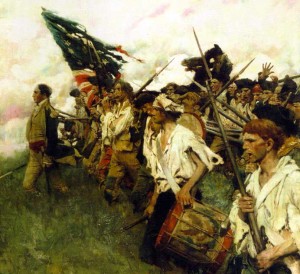Reorganization meeting reaches out to 15 local towns that saw armies in action in 1777 battle
By Mike McGann, Editor, UnionvilleTimes.com

"Nation Makers" by Howard Pyle, the legendary local artist, part of the collection at the Brandywine River Museum. This is Pyle's imagined vision of Gen. George Washington leading troops in battle — some say at Brandywine, although in reality, Washington commanded the battle from a headquarters in Chads Ford.
CHADDS FORD — You may not think you live in a historic battlefield site, but residents of a number of local towns might be surprised to find that they are now considered to be part of the Brandywine Battlefield — at least according to new federal standards.
Because of this, the Brandywine Battlefield Task Force invited officials from 15 local municipalities to an organizing meeting, in an effort to jump start local preservation efforts — and keep the Chadds Ford battlefield park operating.
Because new standards to define a battlefield now include not just where shots were fired, but rather troop movement and pre- and post-battle encampment, a lot more local municipalities are now considered to have been part of the engagement. 15, up from the original six, including Chadds Ford, Pennsbury and Birmingham (where much of the fighting happened).
But now New Garden, Kennett Township, Kennett Square, East Marlborough, Pocopson and Newlin are now considered fully part of the battle. British troops camped and began their march in the early hours of Sept. 11, 1777, to either the banks of the Brandywine in Pennsbury, or, as proved pivotal, a force under General Charles Cornwallis marched north through East Marlborough, Pocopson and Newlin seeking an unguarded ford over the Brandywine to outflank Gen. George Washington’s forces. The flanking movement worked, and the Continentals were routed, saved only by a brave rear guard action in Concord that saved the main body of the American army to fight another day. The defeat did lead to capture of Philadelphia by the British.
While preservation efforts — mostly in the form of development easements — have been focused on Chadds Ford, where the park is, and Birmingham, where most of the actual fighting took place, the task force is looking at a wider world, now.
“We invited you here, to get you re-involved,” said Jeannine Speirs, who serves as chair of the task force, and is a senior community planner for the Chester County Planning Commission, speaking to local representatives of 15 invited local municipalities.
The park — and efforts to preserve the surrounding battlefield area — have been in flux since 2009 when the Pennsylvania Historic and Museum Commission (PHMC) stopped funding the daily operation of the park. Since then, local volunteers and some local governments have been working to keep the park open, albeit in a limited fashion.
Currently, the task force has been driven by Chester and Delaware counties, PHMC (which still funds maintenance at the site), the Brandywine Conservancy, which has led the efforts to acquire easements for much the 2,700 acres of land that has been preserved to date, the Chadds Ford Historical Society and the Friends of Brandywine Battlefield. Speirs said she and rest of the task force wants to re-engage local municipalities, as well as PennDOT and the National Park Service.
The idea would be to have the bigger group meet twice a year, with a smaller steering committee — primarily the group engaged regularly now — meeting monthly to manage day-to-day operations.
As another part of Wednesday’s presentation, Sean Moir of Chester County’s Geographic Information Systems section of the county’s Department of Computer and Information Services showed off an interactive, real-time map of the battle’s events. Moir will be giving a more detailed presentation on June 19 at the Exton Libary.
David Shields, the Associate Director of the Land Stewardship Program from the Brandywine Conservancy, walked the group through the efforts over the last decade to purchase easements — and in at least once case, purchase the property — to make sure that battlefield lands don’t end up as housing developments.
The group is expected to meet again in the fall.








This is taken from a history of Boy Scout Troop 31 (Chadds Ford) written by Bob Hinderlighter, Jr. I hiked this trail 4 or 5 times in the late 60’s and early 70’s…even then, portions of the trail went around lawns and properties. The “on foot” portion actually took Scouts to battles and the routes that troops took….only a very small portion was in the actuall battelfield “park” on US 1. In the early 70’s as a college student, some of my friends and I would camp at “Camp Sanderson”, pick up debris and trash, and no one would ever bother us!!! The troop history portion follows…
“In 1967 a local historic trail was dedicated, the Brandywine trail. It holds special meaning to our unit since we established it!! The first part of this trail was a trip by auto from Kennett Square to Chadds Ford with stops at the site of the old Kennett Friends Meeting House and the site of the first skirmishes of the Battle of the Brandywine, Welch’s Tavern. There were stops in the Kennett area near the Kennett School where the British army camped the night prior to the battle and at the sites of the Shippen House and Unicorn Tavern where the British generals were headquartered. The last point by motorcade was the hill behind Chadds Ford Elementary School where British artillery bombarded the American position.
The second part of the trail was a foot trail from “Camp Sanderson” following the course of the American advance to Birmingham Friends Meeting House.
Camp Sanderson, where those participating in the hike would camp overnight, was developed by our unit with the help of retired Rear Admiral Delmar S. Fahrney. It was located on the banks of Brinton Run, where “Roundelay” the admiral’s estate is located. Troop 24 of Kennett Square assisted us in preparing the camp. The camp was named in memory of Christian Carmac Sanderson, a friend of Troop 31 and well known local historian, who had passed away the previous year. Chris had travelled the trails and roads of the battlefield many times, either alone or as a guide to interested tourists.
At a dedication ceremony held at the Birmingham Friends Meeting House, one of the battlefield shrines, the first Brandywine Trail medals were presented. The first recipients were Troop 31 members Chip Aquadro, Robin Mickel, Mark Ralston, George Saunders, Joseph Voytilla and Kurt Wolter. The medals were presented by retired Rear Admiral Fahrney and witnessed by Ray Schlaantine, past president of Chester County
Council, B.S.A. The medals, which were struck by the Chester County Council, were also presented in other ceremonies to members of Troop 24 of Kennett Square and Troop 22 of Unionville, two of the first units to take the hike.
Troop 31 served as the host troop for the trail, occasionally hiking the trail, performing maintenance of the trail and camp and providing information and assistance to units taking the trail. At some point prior to the mid-1970’s, Camp Sanderson’s use was discontinued and in the early 1980’s the trail itself was discontinued because of residential growth and disruption of the trail.
Steve, can you contact me at campmoreland@gmail.com for more about the Brandywine Historical Trails? Thx! Larry